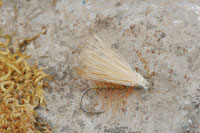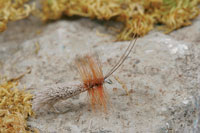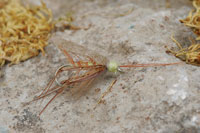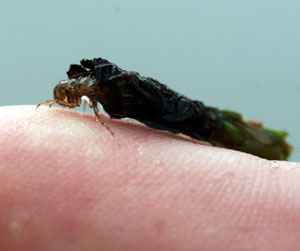There are around 200 different species of sedge (or caddis) fly in the UK, belonging to the order Trichoptera. With the exception of the egg, all stages of the insect’s life cycle are of interest to the fly fisher at some time or another.
From the egg, the first stage of the sedge’s life is the larva. This caterpillar-like creature is easily recognisable as it builds itself a protective case from lake or riverbed debris. It stays in this form for up to a year, before gradually changing into the pupal stage. Once mature, the pupa bites its way out of its protective case before swimming to the surface. This stage is one of the most little fished by the fly fisher, and can lead to many anglers being baffled by the trout. Many of us will have seen seemingly spectacular evening ‘rises’ where fish have ignored every surface pattern we have thrown at them; it’s often because they are charging around taking sedge pupae just sub-surface.
The final stage – and the one featured here – is the adult. With its tent-shaped wings and characteristically long antennae, the insect is unmistakable. Although some species are active during daylight – such as the grannom – most sedge hatches occur in the evening and at night-time. It’s when the adults return to the water’s surface to lay their eggs, often seen skittering across the water, that some truly pulse-racing dry-fly sport can be had!
 |
Elk Wing Olive
Hook: Medium-shank light wire, size 10
Body: Olive floss
Hackle: Red game cock
Rib: Fine gold wire
Wing: Elk hair
 |
GH Sedge
Hook: Long-shank light wire, size 10
Body/wing: Deer hair, spun and clipped to shape
Hackle: Red game cock
Antennae: Stripped hackle stalks
 |
Cinnamon Sedge
Hook: Medium-shank light wire, size 12
Body: Light-olive dubbing
Hackle: Red game cock
Legs: Knotted pheasant tail fibres
Beard hackle: Natural CDC
Wing: Sedge wing sheet cut to shape
Head: Light-olive dubbing
Antennae: Stripped hackle stalks
RODS
Realistically, if you want to really enjoy fishing a sedge hatch and to get the most from playing the fish then, ideally, you should go for a 5-wt rod. If you don’t own one and you’re stuck with a 7-wt then don’t get hung up about it because it will do the job. The lighter outfit will guarantee a more delicate presentation of the fly, though – this can be crucial in flat-calm conditions. It’ll also give you a lot more enjoyment when playing a fish. You can often get away with lighter leaders as well, which can often improve your chances with fussy trout.
LINES
When it comes to lines then there is one that reigns supreme, and that’s the floater. It’s just so versatile. A lot of people think a floater is for surface fishing – not true. Yes, when it comes to fishing flies on the surface it’s the only one, but fish a weighted pattern and every time you retrieve you draw the fly up in the water column, then you let go of the line and the pattern falls back towards the bottom. Look at natural food, like buzzers and sedge pupae, and they behave in exactly the same way.
LEADERS AND TIPPETS
If you’re going to fish a single fly, then make a point of using a tapered leader of some description or another. A tapered leader will help punch a fly into the wind to give better turnover; it’s also a lot more accurate than using a single piece of straight-through leader.
There are occasions when a very thin-diameter leader will make a difference so make sure you have some. It pays to have different leader materials when fishing sedge patterns. When fishing surface patterns, copolymer is nice and supple and gives better movement when stripping a sedge pattern across the surface. Fluorocarbon would be the number-one choice of leader material for fishing patterns just sub-surface due to its sinking properties.
RETRIEVES
There is a whole host of retrieves that will work when imitating adult sedges, so it pays to experiment. There are times when just leaving the fly static can often be the best tactic; get the fly on the water in front of a feeding fish and wait for the take.
The best and most exciting way to fish adult sedge patterns is to make the fish ‘nail ‘the pattern. Cast out, leave everything to settle for 10 seconds, then strip the fly back using 1ft pulls. This creates a large ‘V’ and can prove irresistible to any fish that are in the area.
When fishing the pupa, a stop-start retrieve can be very useful, as can fishing the flies static.
When And Where
There are hundreds of species of sedge in this country, most of which are nocturnal. There are some that hatch through the day, though, the grannom sedge being the main one. However, many more merge around the time when the sun starts to dip below the horizon at dusk. This can extend well into the evening.
Sedges are more or less found everywhere, from lowland reservoirs to moorland streams, so they are more or less guaranteed to be present in your local water. The thing is, the majority of anglers never get to see a hatch because they are usually off the water by the time the hatch is under way.
Life Cycle
The sedge’s life cycle is more or less completed in a year, and for the majority of this time the insect is in its larval form. The pupal stage typically lasts a month or less and the actual adults can live for a few weeks.
The larvae are more commonly known as caddis grubs, and the majority of these live in cases they’ve created from detritus from the bed of the river or lake. When the larvae are fully grown they become pupae. It is from this stage that the insects change to the adult form, which can take days or weeks. When the adults are fully developed they bite their way through their cases and swim to the surface.
The adult flies return to the water to lay their eggs on moonlit nights; this is the time for us anglers to turn to those surface patterns. Exciting sport is sure to follow.






